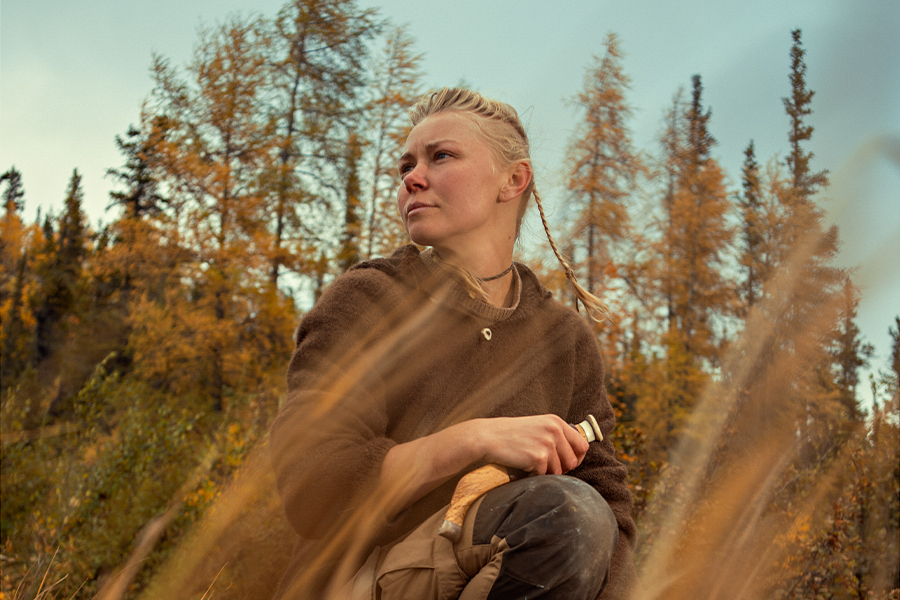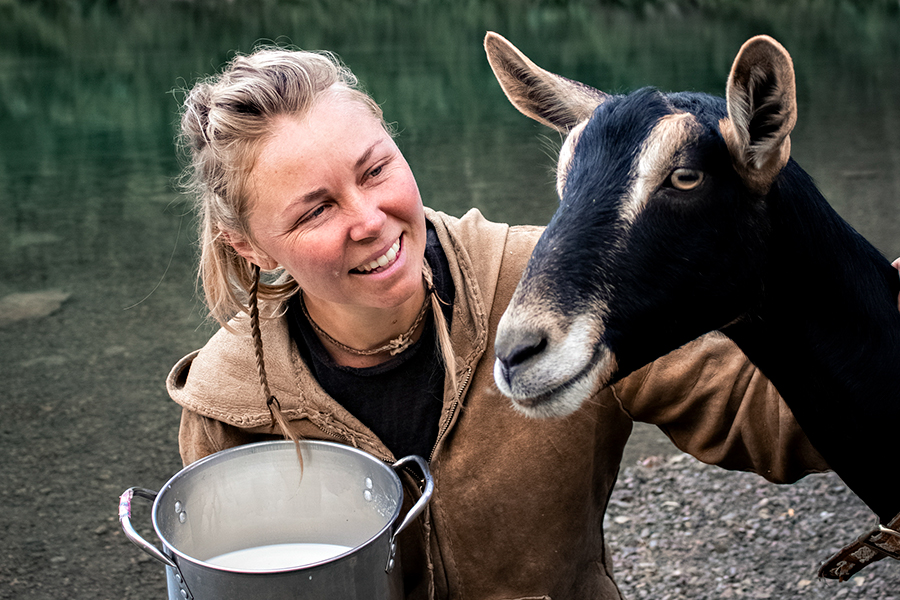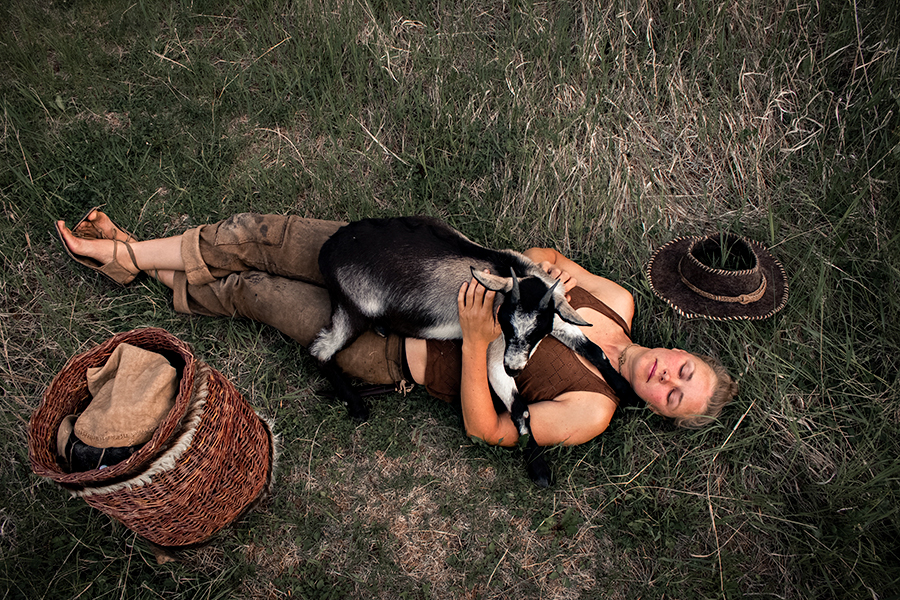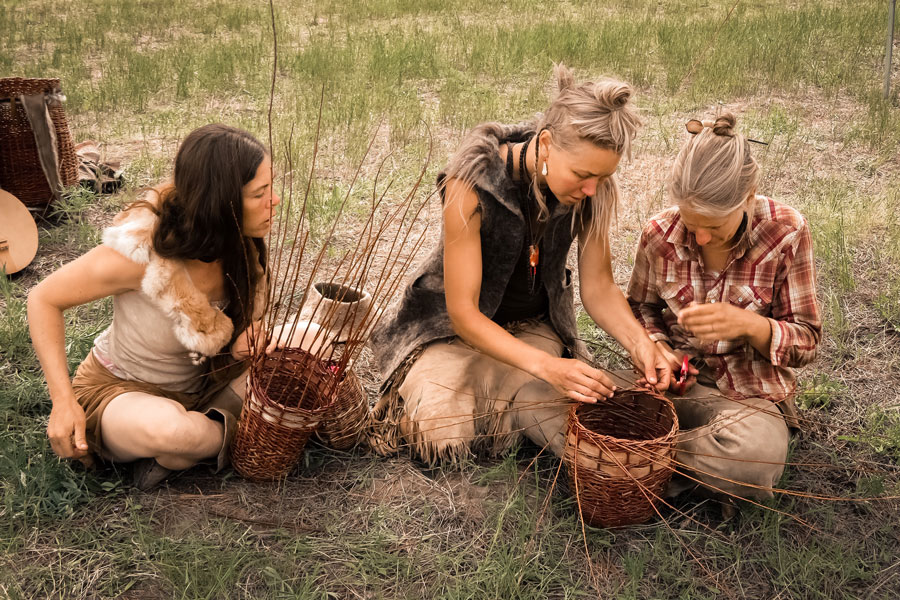Modern Nomad
Callie Russell, who is based out of the Flathead Valley, has committed her adult life to connecting with nature, eschewing technology and mastering primitive wilderness skills. Now she's one of three remaining contestants on the HISTORY show ‘Alone,’ with the season seven finale on Aug. 20.
By Myers Reece
Callie Russell has spent her adulthood largely eschewing modern comforts and often living nomadically, her days defined by the rhythms of the seasons and the bounty of the wild. It’s a lifestyle of extreme intention, as she seeks deeper connections with humanity’s ancient roots, the natural world and her own food sources through foraging, scavenging, hunting, fishing and tending to her herd of goats, which serve as pack animals and provide milk for sustenance.
The closest Russell gets to a 9-to-5 is skinning deer and elk in the fall to procure hides that she tans and transforms into leather goods sold through her business Montannery, while also tracking mountain lions for a conservation project, teaching wilderness workshops, leading backcountry trips, working with hunting guides and practicing ancestral art such as basket weaving.
For the last 10 years, her shelter has been trees, tarps, tents, caves and, during a brief period of decadence, a yurt.
“I haven’t lived in a permanent structure for a decade,” the 32-year-old Russell said last week from her home base in the Flathead Valley, where she lives in a canvas tent outfitted with a wood stove. “My whole adult life has been committed to learning the skills of our ancestors.”
Still, even with her wilderness background and foundation of skills, when a crew for the HISTORY channel show “Alone” helicoptered her deep into the frigid Arctic tundra of Canada’s Northwest Territories last year and dropped her off with 10 survival tools, a limited quota of clothes and camera equipment, Russell questioned her choices.
In fact, doubt had already surfaced well before she stepped into the helicopter.
“Preparing for the trip, I was like, ‘Oh my gosh, did I seriously sign up for this?’” Russell said. “I’m going to be dropped into the coldest place I’ve ever been at the end of fall when everything is getting colder and resources are drying up, and I’m just going to try to stay there for 100 days.”
Russell typically scouts an area before encamping for a long period of time, including previous months-long stays in various Western U.S. wildernesses, but she wasn’t afforded that opportunity for the show, nor did she have a food base. She was starting from scratch in a foreign and unforgiving landscape.
“It was the most extreme environment I’ve ever been in, and I was unfamiliar with it,” she said. “Usually I know what to bring and pack, but here you do the research as best you can and then make your best guess.”
But the peace of mind rendered during previous sojourns in the backcountry eventually emerged to overshadow the uncertainty.
“The longer I was out there, the more that all faded, the more that all dissipated,” she said. “I feel like I dropped into a quieter mind and state of acceptance. I felt a lot of acceptance for whatever was going to happen out there.”

Russell is one of the last three remaining contestants on season seven of “Alone,” which bills itself as the “most intense survival series on television,” and this particular season features the “biggest twist in series history” in which contestants try to survive in the Arctic for 100 days to win $1 million.
To find out how Russell fares, viewers will have to watch the three-hour season finale on Aug. 20 at 6 p.m. MST on HISTORY. According to Russell, anybody tuning in can rest assured that the show is genuine, unlike the heavily scripted and misleadingly edited storylines of many “reality” shows.
“This show is the real deal,” she said.
Contestants self-documented their journeys, without camera crews. Russell said medical teams periodically helicoptered in to perform health screenings and check vitals, but they didn’t answer questions about, say, an infection or perform medical procedures, as doing either would count as the contestant giving up.
“If you ask for their help, that’s ‘tapping out,’” Russell said, adding that the occasional medical crew represented the only other humans she saw during her time in the Arctic.
The crews did provide assistance for the camera equipment, including batteries. But if one of Russell’s 10 items was lost or rendered inoperable for any reason, no replacement was allowed. Her selected tools were: ax, saw, knife, pot, ferro rod for starting fires, sleeping bag, snare wire, fishing line and hooks, bow and arrows, and paracord.
Russell’s survival instruments never gave her any problems, though; it was the film equipment that threw her off. It’s impossible to shoot a bow and arrow while holding a camera, and the motion of setting it down often scared off prey, as did the obnoxious squeak of the tripod on snow.
“I lost many, many meals because of the cameras,” she said.
Serving as a one-person camera crew was also taxing: filming, lugging the equipment around and tending to batteries, microphones, memory cards and the like.
“Self-documenting was so challenging,” she said. “I spent more energy and calories messing with the camera equipment than actually trying to live off the land.”
Russell still managed to harvest an adequate supply of squirrels and snowshoe hares, often in handcrafted traps, as well as porcupine with bow and arrow, providing protein to supplement her diet of foraged berries, mushrooms and plants.
She gathered drinking water from Great Slave Lake. Once the lake froze over, she had to break through ice to retrieve fresh water, although if she set it down for any period of time it would quickly freeze in the Arctic air, so ultimately she got much of her water from melting ice.

Russell grew up in Phoenix but frequently visited the Flathead Valley, where she has multi-generational roots and where she honed an appreciation for the outdoors. As a teenager, she started “wondering where my food came from,” a curiosity that set in motion many hours of research into ancient human cultures and food sources, leading her to question the modern food industry.
“It set me off on this path,” she said.
Russell searched for outdoor-related jobs, including the Conservation Corps in Oregon and later wilderness therapy in Arizona. She began to add real-world abilities to her book-learned knowledge base, and became a regular at primitive-skills gatherings held across the country.
“Once I got a little bit of a foundation, I just set out into the wilderness, going on trips on my own: first a few days, then a week, then a few weeks, and then I was able to go into the wilderness for months at a time,” she said.
Russell acknowledges that even diehards at the primitive-skills workshops usually apply their skills as hobbies, not all-encompassing lifestyles. She has gone through stints where she was “pretty much living out in the wilderness,” only occasionally bumping into backcountry adventurers passing through and at times not seeing or talking to a single human for a month or so at a time.
“When you don’t see any human footprints, that’s when you know you’ve gone really deep,” she said.
These days, however, she says she’s “modernized a little bit more.” She has a truck and a cellphone, but no computer, WiFi or television. She makes calls and sends emails on her phone, which she charges in her pickup but leaves behind when she ventures into the backcountry.
“This is the most plugged in that I’ve been,” she said.
Russell is considering incorporating solar panels into her modern repertoire, and perhaps even building a cabin.
“There might be a little more comfort in the future, a little more stability,” she said, before pausing to consider the concept of stability. “Actually, the main reason for the cabin is insulation. Insulation would be nice.”
Any notion of Russell as a misanthropic hermit is a misreading of both her character and motivations. She’s down-to-earth and friendly, even chatty.
“She’s quite an interesting paradox, someone who has chosen to live a life that most people don’t lead and yet she’s as sociable as they come,” Quinn Caruana, head casting director for “Alone,” said in an interview. “She’s an awesome person. She’s one of my favorite people on or off the show.”
Russell loves get-togethers with friends and family, and cherishes breakfast outings with her grandmother, even if those occasions represent a small fraction of her adult timeline.
“I enjoy spending time with friends and family who live a different lifestyle, and I’m more than willing to do the things they enjoy,” she said. “I find a lot of peace in solitude, but I also find a lot comfort in people. My goal hasn’t been to escape humanity but to find a connection. It’s about immersing myself in the wild, connecting to an ancient way of life and having a deeper relationship with my food.”
“There’s a correlation between my overall wellbeing and my connection to the natural resources that I require to live,” she continued. “The more connected I am to the resources I require to live, the happier I feel, the more purpose I feel I have.”

The crew for “Alone” reached out after hearing about her through word of mouth in the primitive-skills world, where Russell is “very well-known throughout North America,” according to Caruana, who had been trying to get her on the show for two years. As one would guess, Russell isn’t much of a TV watcher and was hesitant, but realized it was a once-in-a-lifetime chance to test her skills and further her life mission.
“My initial reaction was, ‘Oh gosh, I don’t know if I really want to go on TV,’” Russell said. “But the opportunity was too cool, too unique, too awesome to pass up.”
“I didn’t do this for fame or to say I was on TV — that actually scares me,” she added. “I’m a person who likes to live more in the shadows, so stepping out onto center stage was scarier than living off the land for 100 days.”
Even among the show’s rotating cast of survivalist and outdoor specialists, Caruana said Russell is in a “league of her own.”
“She’s a rarity to find because she has already lived and gone through a lot of these challenges in her own life: the solitude, the minimal gear,” Caruana said. “She’s gone solo with really nothing into the desert; she does goat packing in the wild. For us she was a no brainer for the series.”
Beyond her skills in the wild, Caruana said Russell’s vibrant and genuine personality has made her a fan favorite. Her honesty extends to her narration during the show and makes her relatable, Caruana said, and her worldview tends to interpret daunting challenges and potential setbacks as valuable learning experiences.
“Callie is a glass-half-full person,” Caruana said. “The world needs more people like her — humans in general but specifically women. She’s so strong because she’s just strong. It’s not that she’s the strongest out of the women, but she’s strong compared to the men, too. She’s this tiny, slight-of-frame woman who has really held her own on this season.”
Russell especially likes teaching outdoors skills to children, and has done so locally at Ravenwood Outdoor Learning Center. Brett Holmquist, Ravenwood’s cofounder and executive director, said Russell is unique in her capacity to commit so thoroughly to her lifestyle while still finding peace in the mainstream hustle and bustle.
“She’s one of the very few people who knows how to successfully walk in both of those worlds,” he said. “There are people who have had enough of modern society and become reclusive and hang out only with other people who live off the land and have a difficult time integrating back into the modern world, but she’s got this gift of being able to live successfully in both realms.”
Holmquist has developed a friendship with Russell, whom he calls “very humble and generous,” and he has been thrilled to watch her advance through the show. He’ll be tuned in to the Aug. 20 finale.
“We’ll be cheering her on,” Holmquist said. “She’s someone I really, really admire and respect, not only in terms of knowledge in ancestral skills but also as one of the most delightful human beings I’ve ever been around.”
To acquaint herself with the show last summer, Russell watched episodes of “Alone” at the laundromat while she washed clothes. Once she was a contestant, she opted for the homes of friends and family to view it, rather than the laundromat where everybody recognized her as the person on the screen.
While Russell didn’t yet know last week where she’ll watch the finale, with COVID-19 complicating viewing-party possibilities, the results that matter most to her have already been tallied, calculated through the same intangible metrics that have compelled her life’s off-the-beaten-path journey.
“It was so, so challenging, and it would have been easy to spend the whole time in complete misery,” she said. “But I felt so happy, so connected to everything I was doing, to the food I was eating, to this ancient, primal way of living that I’ve missed growing up in the modern world and I’ve longed for and feel like I got being out there.”
“I’m very thankful for the experience; it was incredible,” she added. “One big thing I left with was empowerment. I set off on this journey not knowing what I would be able to do. I doubted myself as I was preparing. But in the end, I felt empowered, like I could do anything. I learned so much about myself and what it means to be a human being living on this planet. It changed me on such a deep and profound level it’s hard to put into words.”